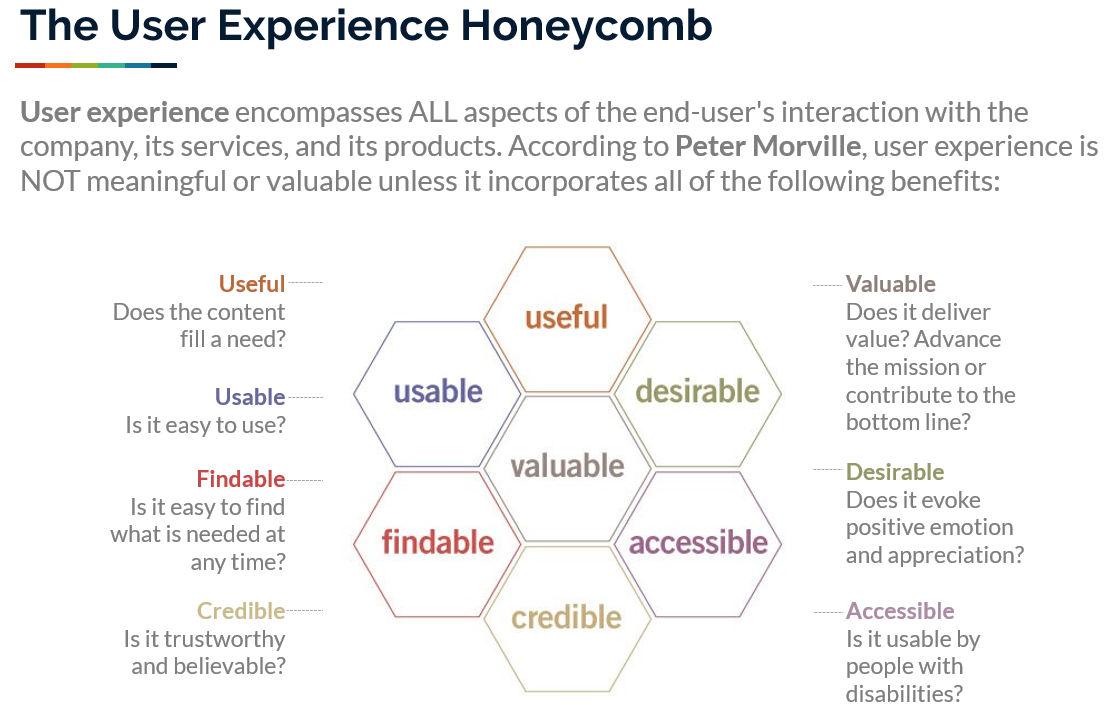

UX: User-Centered Analysis and Conceptual Design Training
2 days (10:00 AM - 5:00 PM Eastern)
$750.00
Register for a live online class.
Details
Subjects Covered
Prerequisites
Setup Requirements
Details
Course Details
An empathetic, user-centered analysis is a basis for interface design that makes sense to the user. With a clear definition of user requirements, developers and designers can create more effective and usable software interface designs. In this course, you will learn the methods and concepts to analyze user-centered requirements—the foundation for designing user-centered interfaces, content, applications, and websites.
This course is designed for UX researchers, UX designers, usability practitioners, website and application developers, interface designers, and project managers.
Subjects Covered
User-Centered Analysis and Conceptual Design
- Introduction to User-Centered Design
- The Benefits of UCD
- Data is Critical
- Team Participation
- Knowing the Alternatives
- Data Analysis in User-Centered Design
- Overview of Analyzing User Data
- Gathering User Data to Analyze
- Quantitative vs Qualitative
- Field Trip
- Observing Users
- Observation Techniques
- Gathering the Information
- Experience Mapping
- Depicting User Interactions
- Building an Experience Map
- Creating a Successful Experience Map
- Actionable Data
- Identifying Pain Points
- Setting Goals
- Understanding Metrics
- Rich User Data in an Actionable Format
- Personas in User-Centered Design
- What is a Persona?
- Personas in User-Centered Design
- Benefits of Personas
- Creating Personas
- Exploring Elastic vs. Concrete Users
- Personas vs. Market Segmentation
- Creating Assumption Personas
- How Many Personas Do You Need?
- Moving to Data-Driven Personas
- Data-Driven Personas Are More Believable
- Gathering Data for Personas
- Maintaining a Persona Data File
- Know Thy User
- Creativity in User-Centered Design
- Understanding Ideation
- What Does Ideation Mean?
- The Local Maximum Problem
- The Benefits of Ideation Techniques
- Ideation Techniques
- Downsides of Brainstorming
- Design Charrettes
- Possible Futures
- Three-Dimensional Design
- Role Play
- Creativity is Key
- Scenarios and Storyboards in User-Centered Design
- Working with Scenarios and Storyboards
- What are Scenarios and Storyboards?
- Benefits of Scenarios and Storyboards
- Creating Scenarios
- Prerequisites for Scenario Creation
- Writing Scenarios
- Tips for Good Scenarios
- Storyboards to Visualize Scenarios
- From Scenario to Storyboard
- Storyboard Creation
- Tips for Good Storyboards
- Prototyping in User-Centered Design
- Paper Prototyping
- What is Paper Prototyping?
- Benefits of Paper Prototyping
- Where Does It Fit in the UCD Process?
- Creating a Paper Prototype
- Building the Prototype
- Materials to Use
- Tips to Paper Prototyping
- User Testing a Paper Prototype
- Users Respond in Different Ways to Paper Prototypes
- Special Considerations When Testing Paper Prototypes
- Tips for User Testing Paper Prototypes
- Using User-Centered Design Artifacts to Create an Implementation Plan
-
- Implementation Planning
- User-Centered Planning
- Where Implementation Planning Fits in the UCD Process
- Story Mapping
- Create a Story Map
- Laying Out the Interface
- Prioritizing Items on the Story Map
- Setting Metrics for Story Map Items
- Content Strategy
-
- What is Content?
- The Content Strategy Process
- The Components of Content Strategy
- A Holistic Approach to Content Strategy
- Key Driving Questions
- Users, Motivations and Goals
- Content Strategy for People
- Identify and Understand Stakeholders
- Understanding Context
- Develop Fact-Based Personas
- Extend Personas with Empathy Maps
- Analysis and Structure
- Substance and Structure
- The Quantitative Content Audio
- The Qualitative Content Audio
- Content Models
- Create Once, Publish Everywhere
- Scenarios and Activity Flows
- Information Architecture and Wireframing
- Guides, Templates and Workflows
- Voice and Tone
- Style Guides
- Examples and Templates
- Workflows
- Creation and Management
- Governance and Ownership
- Who Creates the Content?
- Budgeting and Advocacy
- Measuring Success
- Next Steps
Prerequisites
Before Taking this Class
UX: A Deep Dive into UsersSetup Requirements
Software/Setup For this Class
None
Onsite Training
Do you have five (5) or more people needing this class and want us to deliver it at your location?

